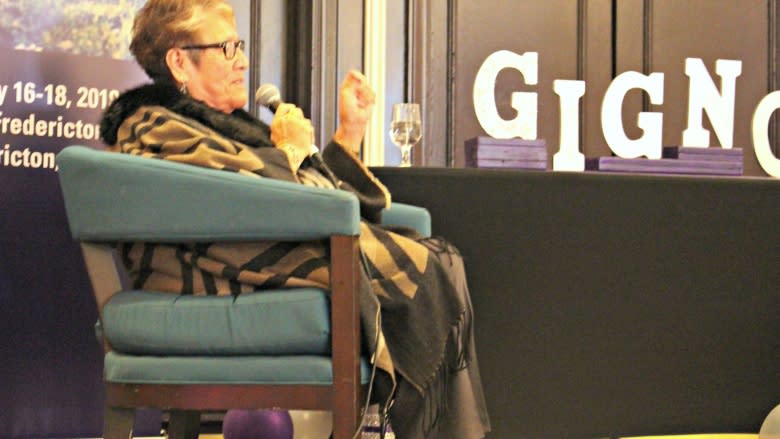Gignoo Transition House marks 25 years of helping First Nations women escape violence
For many Indigenous women, escaping domestic violence means more than leaving their abusers and their homes, it means leaving their entire community as well.
For 25 years, Gignoo Transition House has tried to provide a safe place to stay for women fleeing violence.
The safe house, the only one in New Brunswick specifically for First Nations women, marked its 25th anniversary this weekend by hosting a conference featuring a variety of speakers and workshops.
Gignoo means "our home" in both Mi'gmaq and Maliseet.
That's what the safe house, which is located in Fredericton, endeavours to provide for First Nations women, said Barb Martin, president of the board of Gignoo Transition House.
"For Indigenous women, they're often not just leaving their house, they're leaving their home, which is the community itself," she said.
"They're leaving their culture, their support system, their extended family network to come to a home off-reserve. That's an extra challenge."
In addition to providing housing and support services, Gignoo House also has staff that speak Mi'gmaq and Maliseet and works Indigenous culture into its day-to-day practices.
For example, it has daily smudging available for both clients and staff, says Shelley Germain, executive director of Gignoo Transition House.
"That brings it back to the culture and offers them comfort," she said.
"It's a very hard transition sometimes, coming from the reserve to the city."
'It was a pitiful sight'
As a part of a panel discussion Saturday, Elizabeth Levi, who helped found Gignoo Transition House, described how the safe house began.
Levi says she was part of the New Brunswick Native Women's Council at the time, and was tasked with developing a project focused on family violence.
As part of the project, she and a colleague visited women's shelters throughout the province.
At the shelter in Edmundston, Levi says she witnessed a young First Nations woman curled up on a couch, hugging her knees and rocking back and forth, her face and limbs black and blue with bruises.
"It was a pitiful sight," she said.
After that, she knew New Brunswick needed a halfway house for Indigenous women.
She got to work gathering support letters, and even received one from former Prime Minister Jean Chretien after running into him at the Ottawa airport.
Stemming the tide of violence
Twenty-five years later, the fact that Gignoo Transition House is still standing is bittersweet.
"When I first started at Gignoo I really thought, I'm going to work myself out of a job, because I'm going to fix everything," said Germain, who has been executive director of the safe house for seven years.
"And I was so mistaken."
"What's heartbreaking is we'll be celebrating 50 years in 25 more years. I really think that at some point, when we get to that 50 years, we're hoping to have everybody safe and really rebuild Indigenous women and children."
Martin said she wasn't sure whether violence against Indigenous women has gotten worse or better over the last 25 years.
But the issue is much more visible now, she said.
"I would say it's much more clear, the degree of violence Indigenous women are dealing with," she said.
"There were missing and murdered Indigenous women 25 years ago. We know that. Is is escalating? I hope not. But my gut instinct tells me it's just as bad, if not worse."
"We're hoping that this work that we're doing will put forward the awareness that will stem the tide of violence against Indigenous women."



